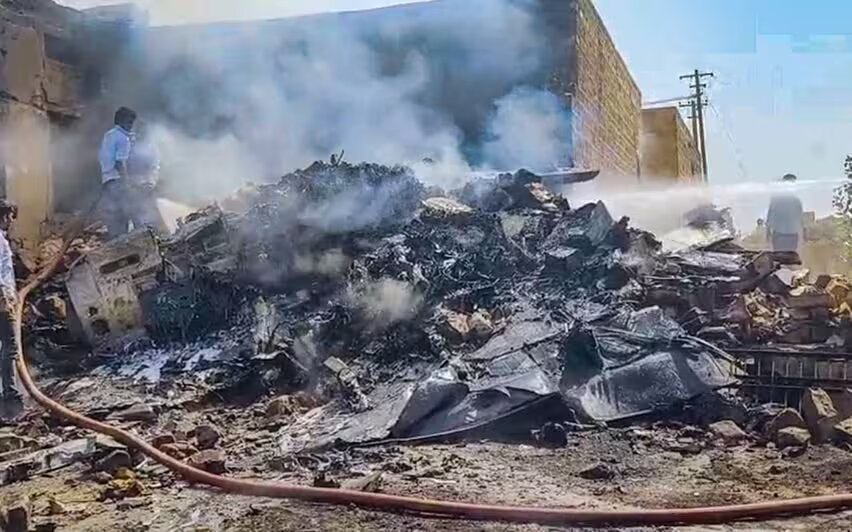According to people who know about the situation, an Indian Air Force Tejas plane crashed near Jaisalmer on Tuesday. The plane had just finished a tri-services drill that was meant to show how far India has come in becoming self-sufficient in the defense manufacturing sector.
Light combat aircraft (LCA) Tejas have been used by the IAF since July 2016, but this is the first crash of one of them.
“An IAF Tejas plane had an accident today at Jaisalmer while it was on an operational training mission.” The driver jumped out safely. The IAF said in a statement that a Court of Inquiry has been set up to find out what caused the crash.
Before it crashed, the plane had been part of the Bharat Shakti drill with another Tejas fighter at the Pokhran firing range near Jaisalmer.
Prime Minister Narendra Modi, Defence Minister Rajnath Singh, Chief of Defence Staff General Anil Chauhan, IAF Chief Air Chief Marshal VR Chaudhari, Army Chief General Manoj Pande, Navy Chief Admiral R Hari Kumar, and other people were there to see the drill. The two fighters fired flares.
Bharat Shakti, an integrated tri-services “live fire and manoeuvre” drill, showed how the Indian military plans to use its own skills to take control of the battlefield and destroy any threat to the country’s safety.
Aside from the LCA Mk-1, the exercise included a number of other weapons and systems, such as the light combat helicopter Prachand, armed advanced light helicopters, T-90 tanks, BMP-II infantry combat vehicles, precision guided munitions launched by drones, rockets, air defense weapons, and artillery guns such as the Dhanush, Sharang, and K9 Vajra.
“The idea of Viksit Bharat is unimaginable without Atmanirbhar Bharat,” Modi said in his speech, stressing the need to rely less on other people. Fighter jets, helicopters, missile systems, and artillery guns made in the country show how well the country’s drive for self-reliance is working.
“We are seeing the rise of Made in India with weapons and ammunition, communication tools, cyberspace, and cyberspace.” He said, “This is Bharat Shakti.”
In February, Tejas fighters took part in Exercise Vayu Shakti-24 at the Pokhran air-to-ground range. They showed off their ability to switch between roles by attacking targets in the air and on the ground. Fighter jets took part in the drill with the theme “Lightning Strike from the Sky.” They hit simulated enemy aircraft and targets on the ground, such as runways, bridges, ammunition dumps, radar sites, terror camps, thermal power plants, and ordnance factories, with great accuracy.
It was in November that Modi flew in an LCA in Bengaluru. He said it was a “incredibly enriching” experience and praised the country’s own defense. People saw his flight in an LCA Mk-1 fighter jet as a big support of the LCA program. It also brought attention to the locally made fighter jet that the IAF wants to buy in large numbers and that India also wants to sell abroad.
In February 2021, the IAF bought 83 Mk-1A jets for ₹48,000 crore. They want to buy another 97, which will cost about ₹67,000 crore. Hindustan Aeronautics Limited, a state-run company that makes planes, gave Chaudhari the first trainer version of the LCA Mk-1 in Bengaluru in October 2023. The two-seater plane would be used for training and could also be used as a fighter if needed.
The plane is part of a larger order for 40 Mk-1 jets in both the basic initial operational clearance (IOC) and the more advanced final operational clearance (FOC) versions. These are the first types of LCA. IAF has added 32 single-seater jets to the 40 Mk-1s and raised two LCA groups. The last eight planes are all trainees, and they will all be given to the IAF by March 2024.
This crash happened just as the Indian Air Force is getting ready to receive its first Mk-1A plane by the end of March. By 2028, the last of the 83 jets that have already been bought will have been sent.
As time goes on, the LCA will become the most important part of the IAF’s fighting power. The Indian Air Force (IAF), which is the fourth biggest air force in the world, plans to use about 350 LCAs (Mk-1, Mk-1A, and Mk-2 versions). About a third of these have already been ordered and some have already been put into service. The rest are a big part of the air force’s plan to modernize and will likely be bought in the next few years.
The later versions, the Mk-1A and Mk-2, will have many more features and technologies than the current Mk-1 plane.
The Indian Air Force (IAF) will put LCAs at forward air bases in the western sector to make them more ready for battle against Pakistan and to fill the gap left by the slow retirement of MiG-21 fighter jets from the Soviet era.
